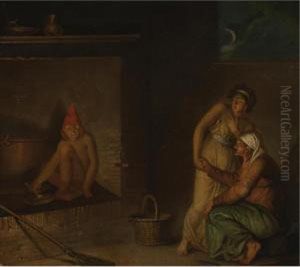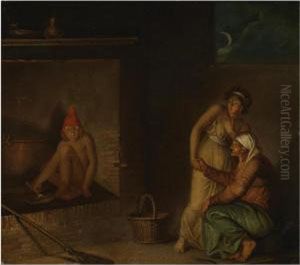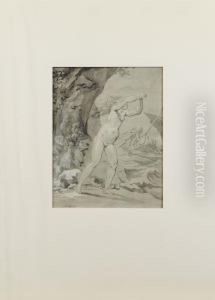Nikolaj-Abraham Abilgaard Paintings
Nicolai Abraham Abildgaard was a prominent Danish painter, architect, and antiquarian whose work and teaching were highly influential in the late 18th and early 19th centuries. Born on September 11, 1743, in Copenhagen, Denmark, Abildgaard was deeply embedded in the intellectual and artistic movements of his time, reflecting the Enlightenment's values and the burgeoning Romanticism in his diverse works. His father, Søren Abildgaard, was a well-known naturalist and antiquary, which likely influenced Nicolai's early interest in history and the arts.
Abildgaard studied at the Royal Danish Academy of Fine Arts from its inception in 1754, where he demonstrated remarkable talent and versatility. His education was not confined to Denmark; with the support of scholarships, he traveled extensively in Europe, particularly in Italy, where he was profoundly influenced by classical art and the works of the Renaissance masters. These experiences were pivotal in shaping his stylistic development, blending neoclassical ideals with a dramatic intensity that was characteristic of the emerging Romantic sensibility.
Throughout his career, Abildgaard was not only a prolific painter but also an esteemed architect and designer. He was deeply involved in the artistic direction of the Royal Danish Theatre and contributed significantly to the interior design of Christiansborg Palace in Copenhagen. However, many of his works for the palace were destroyed in the fire of 1794, a devastating loss to Danish cultural heritage.
As a professor and later director at the Royal Danish Academy of Fine Arts, Abildgaard played a crucial role in educating and influencing the next generation of Danish artists, including the famous Bertel Thorvaldsen. His teachings and works emphasized the importance of historical and mythological themes, imbued with moral and intellectual depth.
Nicolai Abraham Abildgaard's legacy is marked by his contributions to the development of Danish and Scandinavian art, blending classical influences with a unique interpretative depth. His death on June 4, 1809, marked the end of an era, but his influence persisted, nurturing the seeds of Romanticism in Denmark and beyond. Abildgaard remains a celebrated figure, remembered for his artistic versatility, intellectual breadth, and profound impact on the cultural landscape of his time.


